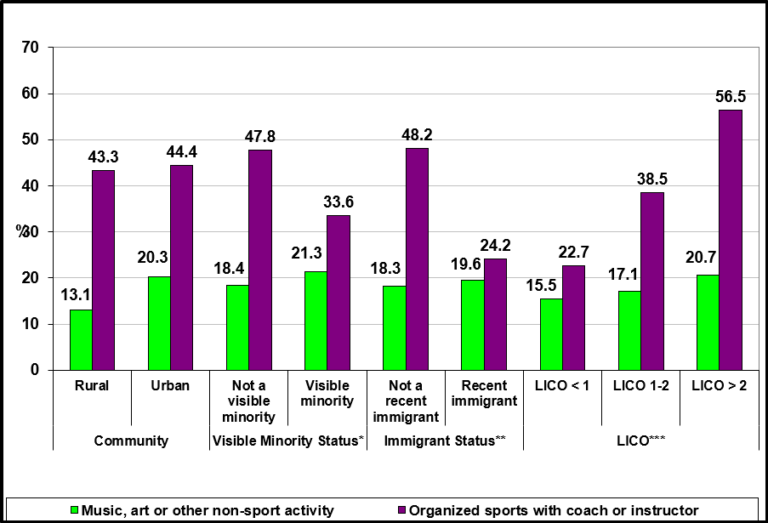3.4.5 Proportion of children aged 3 to 5 years who participated in activities once a week or more, by activity and selected characteristics, Canada, 2010/2011

Notes:Low and high scores were determined by the 10th/90th percentile cutpoints (as appropriate).*Self-identified as belonging to a racial or cultural group other than “White” (does not include Aboriginal). **At least one parent reported that they had become a landed immigrant in Canada in the 10 years prior to the survey. ***LICO (low income cut off) data based on postal code information.
Source: CICH graphic created using data adapted from the Survey of Young Canadians 2010/2011, Statistics Canada – custom runs.
Young children (3 to 5 years) who are members of visible minority groups, recent immigrants and living in low income were less likely to participate in organized sports with a coach or instructor, once a week or more.
There are no appreciable differences between children living in rural or urban settings regarding participation in organized sports.
When it comes to participating in music, art or other non-sport activities, children living in urban settings were more likely to participate than children living in rural settings. Again, children in higher income families were more likely to participate in both arts based activities and organized sports than those in lower income families.
Implications
Children benefit from participation in recreational activities, and this benefit may be even more pronounced among children living in lower socio-economic conditions. Evidence shows that disadvantaged children who participate in arts and sports activities have even greater improvements to their self-esteem and social skills. The fact that children living in poverty and recent immigrant children are less likely to participate puts them at a disadvantage. Opportunities to support vulnerable children and families include addressing some of the barriers they face, such as registration fees, language and cultural/value differences.1,2
1Child Trends. 5 Ways the Arts are Good for Kids. 2017. https://www.childtrends.org/child-trends-5/5-ways-arts-good-kids/ -accessed July 24, 2017.
2Torjman, S. Culture and Recreation: Links to Well-Being. Caledon Institute of Social Policy. 2004. http://www.caledoninst.org/Publications/PDF/472ENG.pdf -accessed July 24, 2017.
